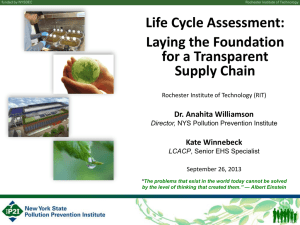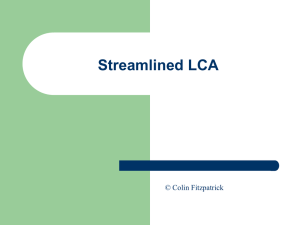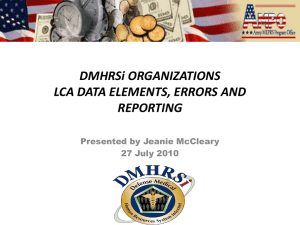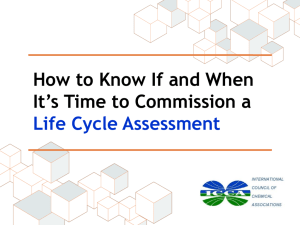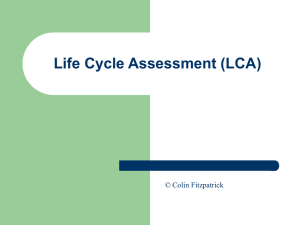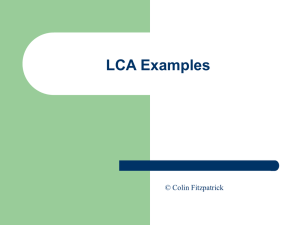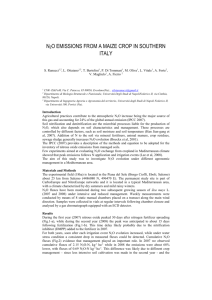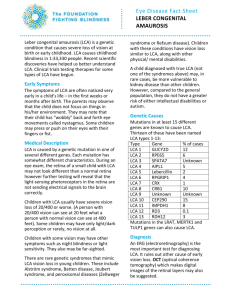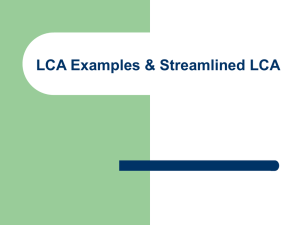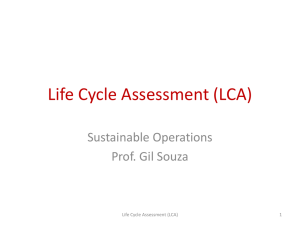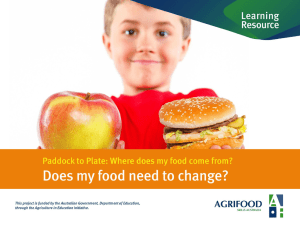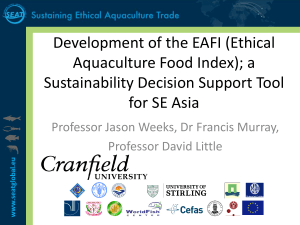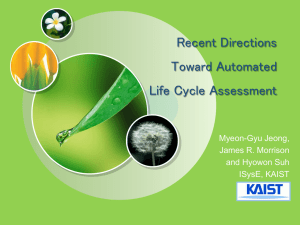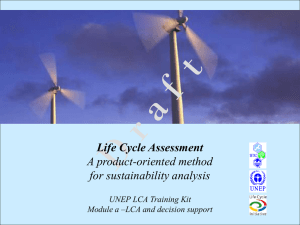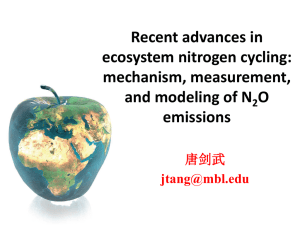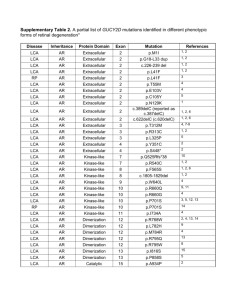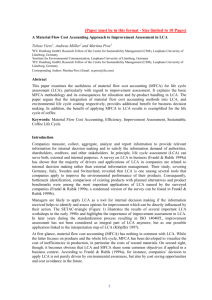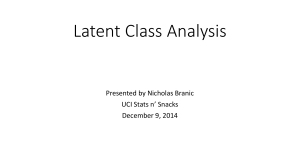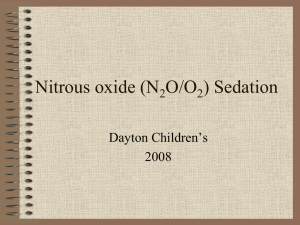Chapter 9 Agriculture
advertisement
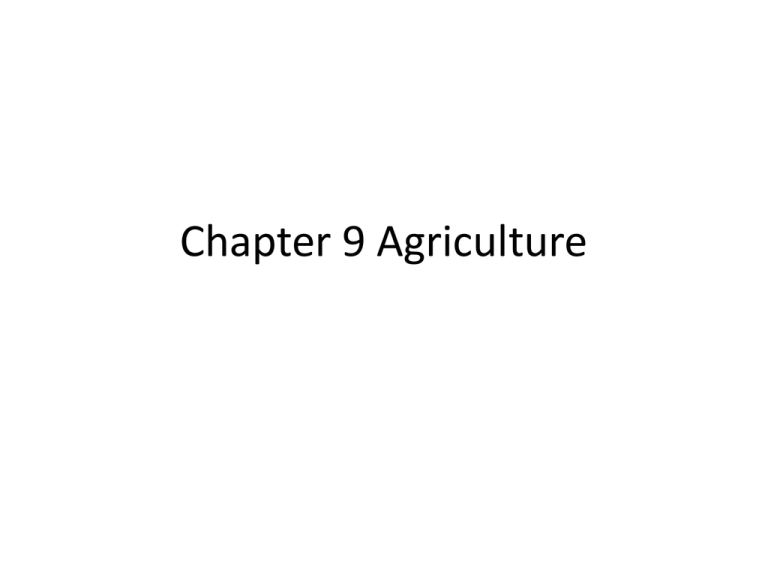
Chapter 9 Agriculture Introduction • Agriculture results in major environmental impacts • 8.5 to 16.5 Pg CO2e/yr (17 to 32% of total released) • N2O and enteric methane major contributors – N2O from fertilizer – Enteric fermentation from animals – Growing meat consumption • N2O emissions growing 9.2 Problems with LCA in Ag • Widely varying practices • Lack data sources of individual processes like seen in a factory • Differences in soils – N2O emissions strongly influenced by soil moisture • Big thing is co-products – Prime beef, regular, mechanically recovered, hides, tallow, etc. 9.3 Sugarcane • Different crops for sugar production • Generally want the highest return ($/ha) • Farmers can shift to different crops and rotations according to prices • Multiple uses for sugar crops – Ethanol – Sugar – Combustion of fiber 9.3 Sugarcane • Cradle to grave assessment using Ecoindicator 95 • Functional unit tonne of sugar leaving mill • Impact categories – – – – – Energy MJ GHGE kg CO2 eq Acidification potential (g sulphate equiv) g SO4-2 eq Eutrophication potential (g phosphate eq) g PO4-3 eq Fresh water use kL Initial Findings • Crop production dominates environmental burdens – relative to processing • Two problems – Variability in crop production systems – Many of the environmental impacts dominated by dynamic soil process • These processes are not very well understood • Linked it with a soil model on N uses Variability – Sensitivity Analysis • Three scenarios allow for an average and 2 extreme results – Handled by looking at state average farming system – Wet tropics scenario (low N, no irrigation, lower cane yield) – High yield scenario (high N and irrigation) Allocation of Inventory Flows • Co-products handled with economic allocation and system expansion • Using economic allocation – Raw sugar (96%) and molasses (4%) – 143 kg sugar and 26 kg molasses per tonne cane – $300/tonne sugar and $70/tonne for molasses System Expansion • Difficulty with equivalence when dealing with substitution of the coproducts • Molasses replaces 40% barley (supplement pasture), 20% of wheat (ethanol fermentation), and 40% nothing (attractant for cattle) • Results almost identical for each allocation approach Other Allocation Options • Mass – Divide allocation by mass of products and coproducts – 169 kg of products per tonne of cane, sugar is 85% of mass • Energy – Look at energy value of each product and coproduct – Split allocation by energy output – Maybe a little difficult with DDGS versus ethanol Results • Agricultural activities biggest factor, processing minor • Eutrophication potential – Emissions to air ammonia, N2O and NOx – Water emissions primarily due to nitrate NO3-, phosphate, PO4 – Differences due to climate, soil type – High yield and low yield cases resulted in similar energy yields Areas for Data Improvements • Environmental conditions – climate, soil type, topography • Agronomic practices • Geographic location relative to supporting infrastructure Conclusions • Variability should be considered carefully in ag crop production, particularly with environmental impacts • Traditional LCA models an average process, agriculture makes this difficult • Opportunity for quick LCA’s on field scale • Optimized sugar cane production, not necessarily best use of land • Some production practices are difficult to change – peoples behavior 9.4 Milk Production • Conventional milk versus ultra high temperature (UHT) milk – UHT is heated very quick and hot relative to conventional milk – Shelf life of 6 to 9 months – Stable at room temperature Results – % of Total Energy Type Packaging Farm Manufacturing Retail Transport Conventional 14 21 14 3 UHT 19 13 18 19 UHT is higher overall in energy. This is due to the longer transport distances, not as many processing plants. 9.5 Maize to Maize Chips • Considers soil GHG balances (including N application) and extends system to include processing • Functional unit 400 g packet of corn chips • Measurement unit were kg CO2 eq/packet Measurements • Went to processing facility • On-Farm measurements of N2O – Previous 5 years focused on stubble and soil carbon dynamics – Looked at following N fertilization • Zero N and stubble burned • 329 kg N/ha and stubble burned • 329 kg N/ha and stubble tilled into soil Results • 6% of emissions are pre-farm (mfg inputs) • 36% on-farm – N fertilization largest GHGE on-farm • 58% post-farm – Electricity for processing biggest factor – Boxes, transport and oil large factors also Results Fig 9.3 Horne et al., 2009 Comments on Fig 9.3 • Pre and on-farm operations add $0.4/kg CO2 eq • Processing has $2/kg CO2 eq • Pre and on-farm are adding less value per unit of GHGE • Makes it harder to invest in abatement strategies – Electricity, packaging, and transport maybe a bigger impact per dollar 9.6 Food Miles • Local versus global food production • Idea is that local food with minimal transport is more environmental friendly • Two issues – Food production is about more than transportation – Assumes transport is dominate environmental impact in food production systems – In general, transport of raw foods relatively small Food Mile Studies • Some studies indicated that shipping tomatoes from Spain instead of greenhouses in the UK was less impact • Some areas have advantages in crop production – New Zealand has year round grazing • Shipping fruit from the other hemisphere might be better than storing for 1 year Differences in Shipping • Ambient shipping by sea low impact (although bunker fuel is very dirty) • Road trucking in refrigerator trailers is energy intensive • Air would be even worse CSA Impact • May minimize some of the negative impact relative to conventional food systems • Less chemical use, less erosion, less packaging, fewer food miles, and more crop and ecosystem diversity • However, few systematic and complete LCA’s to justify these statements 9.7.1 Ag Sustainable • Ag is a major problem (emitter) and potential savior (biofuels and carbon sinks) • LCA useful for comparison different options for a similar product or service – Wool and nylon (nylon actually better, but not natural) 9.7.2 Constraints on LCA Applications to Ag Systems • Climate change impacts on ag pests, diseases, crop growth, yields, and water poorly understood • Time boundaries – fertilizer or lime available over multiple years • Most systems are “established” land use change “water under the bridge” LCA and Ag Systems • Timing and nutrient cycles poorly understood – Land clearing – Fuel use on farm – Fertilizer – Water – N2O – Some studies have indicated that biofuels were worse than fossil fuels due to N2O – This focused on GHGE – Might need more of the eco-indicator type analysis (chapter 5) Ketchup Example • Wide variation in tomato cultivation phase • Production of ketchup fairly well defined • Use at home a problem – Bottle in refrigerator for 1 year had 90% more embodied energy than a bottle used in 1 month • Room for “quick” LCA tools for on-farm/field use 9.7.3 Issues Beyond LCA and Interface Between Other Decision Tools • Two apple production systems is a fair use – Other factors would include rural landscape, natural heritage, wildlife diversity – LCA will have trouble with some of these factors • Economic factors – Food production is high in the US and EU (20% of land is set aside) – Potential food problems in the future Key Questions • What is limiting – Land – GHGE – Water • Will vary by geographic location • LCA need for evaluating conventional and new ag systems – Look for maximum societal benefits 9.8 Conclusions • Ag LCAs are important – Land use, water use – GHGE – Pollutants – Fertilizer, N2O • LCA can help with counterintuitive results – Food miles – Natural versus synthetic Ag Stakeholders • Need to be effort to educate stakeholders on the roll of LCA • Calculators need to be made available for farmers • Economic impact and GHGE (corn chip example) – Less income derived from farm side than processing
